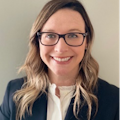The aging population and oral disease prevention: Are dental hygienists ready?
Many of us have heard that people are living longer and keeping their natural teeth. This sounds like a good thing, right? Of course it is, but are we prepared for these people in our operatories? Are we ready to offer them the best in prevention? How comfortable are we with treating aging and frail patients?
Life expectancy has increased from an average of 68 to 81 for women and 76 for men. In fact, it is anticipated that by 2034, older Americans will outnumber children in the US for the first time. As of 2018, people 65 and older numbered 52.4 million, and it’s predicted that by 2040 that will climb to 80 million, accounting for 21% of the population.1 That is significant! How ready are we?
You might also be interested in:
Meeting the dental needs of an aging population
Steps dental hygienists can take
Whether we go to patients in an alternate setting such as a long-term care facility, or they come to our offices, we’re all going to see an increase in older patients. Some of their common oral health challenges are declining oral home care, which leads to increased plaque and calculus buildup; xerostomia; root caries; and recurrent decay around existing restorations. They also face challenges unrelated to oral health, such as changes in dexterity, increased daily medication use with possible side effects, mild to moderate memory loss, dependency on caregivers, and a lack of dental insurance.
Has a patient ever told you, “I’m retiring next month so I need to get all my dental work done before then”? There’s a reason they say that. When someone turns 65, they’re eligible for Medicare. Most Medicare plans do not offer dental coverage, and many aging Americans live on limited incomes such as social security or disability.2 So one of the highest-risk populations faces many challenges, likely with no dental insurance and limited financial means to address their oral health problems. It is estimated that more than 17 million older adults fall below 200% of the federal poverty line.3
I learned from firsthand experience
My interest in this population comes from my days spent in public health and providing dental care in a nursing home. I was hired by a Federally Qualified Health Center (FQHC) to start a school-based sealant program, which is where I’d spent the previous five years. That was January 2020, and COVID forced me to change plans. I found myself working in a nursing home with a patient population I had very little experience treating.
This showed me many things, primarily the uphill battles these patients face. It also showed me that we must think of this population with a different mindset, a prevention mindset. Many of these patients already have significant dental needs, but there are many opportunities for us to help prevent future disease.
We need to make our treatment and prevention services affordable. Some options include frequent silver diamine fluoride (SDF) treatments for caries arrest and preventive applications, offering fluoride varnish, suggesting 5000 ppm toothpaste use twice a day, and dry mouth relief recommendations that offer a neutral pH. We must research the products and services we offer because not all products are created equal, particularly dry mouth products.
I hope I’ve brought awareness to this high-risk population. Many aging adults are at risk for future dental disease, and we have the power to change that trajectory. As dental hygienists, education and prevention are at the core of our practices. This population needs us to be creative and innovative with the options we provide. If we wait until there’s decay under a crown or bridge, or the start of a class V lesion, it’s too late.
We must get ahead of the disease. This is where preventive applications of SDF, incorporating more fluoride exposure, and increasing xylitol exposure by recommending dry mouth products are incredibly beneficial. Aging is challenging, and we have the power to help patients prevent future disease and improve their quality of life!
References
1. Older people projected to outnumber children for first time in U.S. history. United States Census Bureau. March 13, 2018. https://www.census.gov/newsroom/press-releases/2018/cb18-41-population-projections.html
2. Medicare Dental Coverage. Centers for Medicare & Medicaid Services. 2023. https://www.cms.gov/medicare/coverage/dental
3. Get the facts on economic security for seniors. National Council on Aging. 2023. https://www.ncoa.org/article/get-the-facts-on-economic-security-for-seniors
About the Author
Brooke Crouch, RDH
Brooke Crouch, RDH, is a remote supervision dental hygienist, outreach coordinator, advocate, educator, oral health champion, consultant, and volunteer. She has successfully advocated for a dental policy change to Medicaid in Virginia, and for a law change allowing medical assistants to apply fluoride varnish to children. Crouch is vice president of the American Mobile Dentistry Alliance and chairs and sits on several clinical advisory, oral health action, and community-based boards and committees. Contact her at [email protected].
Updated August 26, 2020

